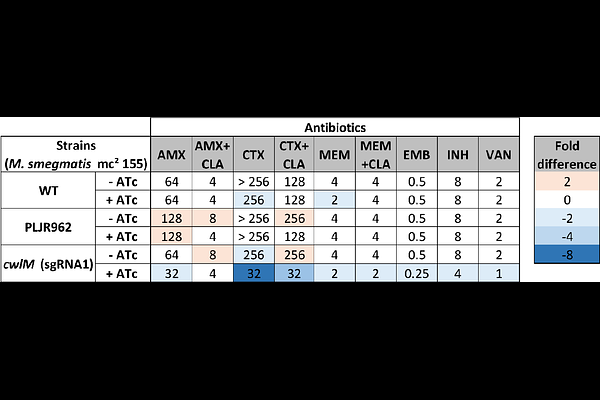Effects of CwlM, a peptidoglycan synthesis regulator, on beta-lactam resistance and host-pathogen interactions

Effects of CwlM, a peptidoglycan synthesis regulator, on beta-lactam resistance and host-pathogen interactions
Silveiro, C.; Mortinho, D.; Olivenca, F.; Mandal, M.; Pires, D.; Anes, E.; Catalao, M. J.
AbstractBackground: The emergence and spread of multidrug-resistant (MDR) strains of Mycobacterium tuberculosis (Mtb) urge the development of novel drugs and efficient therapeutic programs. A recent study aiming to uncover differential beta-lactam susceptibility phenotypes in clinical strains of Mtb found that the M237V substitution in cwlM (Rv3915) was associated with increased susceptibility to amoxicillin. Considering that Mycobacterium smegmatis (Msm) is a widely used surrogate model for Mtb, we constructed a cwlM knockdown mutant in Msm using CRISPR interference (CRISPRi) to elucidate the role of CwlM in beta-lactam susceptibility and intracellular survival. Results: Quantitative RT-PCR assays confirmed the successful repression of cwlM, while the phenotyping assays confirmed the essentiality of CwlM-related processes for mycobacterial viability. Collectively, the antibiotic susceptibility assays suggested that CwlMSMEG may promote beta-lactam resistance, particularly to meropenem and cefotaxime. Moreover, CwlMSMEG was found to support M. smegmatis intracellular survival within THP-1-derived macrophages. To address conflicting reports regarding its predicted peptidoglycan (PG) hydrolase activity, we purified recombinant CwlMTB. The Micrococcus luteus-derived PG-based zymogram indicated that CwlMTB lacks PG-hydrolytic activity, suggesting it might act as a regulator of PG biosynthesis instead. Conclusions: Our findings indicate that CwlM contributes to beta-lactam resistance and intracellular survival, regardless of lacking detectable PG-hydrolytic activity. Overall, CwlM was found to be essential and highly vulnerable, highlighting its potential as a therapeutic target that warrants further investigation.